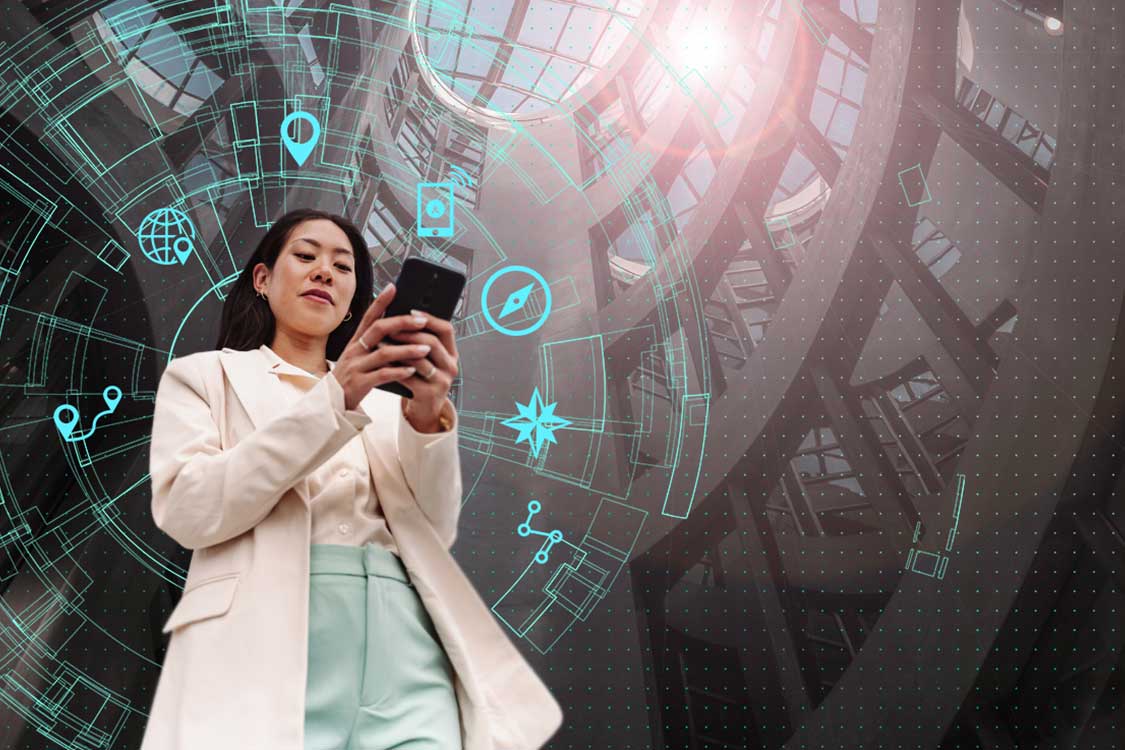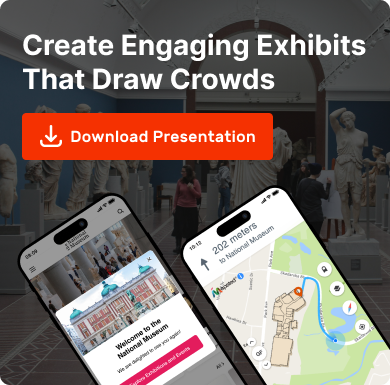Museums & Galleries

Museums around the globe are coming of age, with more venues realizing how state-of-the-art technology for museums enhances the visitor experience. According to the global museum sector online publication Museums + Heritage Advisor, technologies becoming standard in museums and heritage sites include innovations such as projection mapping, binaural technology, holographic displays, contactless donations, app guides, virtual reality (VR) and even visitor flow technology.
While most of these technologies directly impact the museum visitor experience, location-based intelligence such as visitor flow technology helps museums understand how visitors interact with exhibits and move within the building’s footprint. The data gathered reveals the exhibits visitors are drawn to most, and this information helps to create experiences that will keep visitors returning. Indeed, location-based technology has much to offer the museums, because understanding what engages your audience keeps the museums robust and relevant.
According to the global museum sector online publication Museums + Heritage Advisor, technologies becoming standard in museums and heritage sites include innovations such as projection mapping, binaural technology, holographic displays, contactless donations, app guides, VR and even visitor flow technology.


How to Improve the Museum Visitor Experience?
For visitors, finding their way around large museums and galleries can often be a guessing game without the right tools. What if there was technology innovation in museums that helps visitors navigate your space, helps you create engaging exhibits, reaches fundraising targets and attracts more people? Mapsted’s location-based technology solutions for museums can do that and more.
Mapsted is in an elite space when it comes to location-based technology. It’s the only solution that does not require Bluetooth beacons or any external Wi-Fi or hardware. With 100+ patents awarded, the company’s engineering team makes magic happen, offering countless applications in addition to indoor navigation.
Mapsted’s advanced indoor navigation solutions can transform the role of technology in museums. Location-based tech can deliver an interactive, beacon-free wayfinding experience to help guide gallery and museum visitors using highly accurate indoor position technology. Upon entering the museum, visitors simply scan a QR code to access the Mapsted app giving them all the information they need for a heightened, customized experience.
Get to Know Your Visitors
In addition, you will be able to use location- and behaviour-based messaging and real-time location intelligence to send personalized welcome messages to visitors, upsell related products in your gift shop and gain valuable feedback. You can get to know your visitors with real-time data insights to understand what fascinates them the most. This gives you the insight to curate exhibits they really want to see, saving you time and money, while heightening your visitors’ experiences.
Technology has revolutionized the way museums operate in the 21st century. Digital tools and marketing solutions are being used to create state-of-the-art experiences for visitors. Museums also use innovative technologies to optimize their operations and make them more cost-effective.
Know What Your Visitors Want
With technology, visitors can explore and engage with exhibits in ways that were unimaginable before. With digital mapping solutions, museums can provide visitors with a seamless navigation experience. In addition, relevant content can be accessed without the need for external hardware. This can help enhance the visitor’s experience by providing an interactive way of exploring the museum. Furthermore, Mapsted’s indoor navigation solutions can provide visitors with detailed information about each exhibit as they move around the museum. This will enable them to learn more about the artifacts and their history in an engaging manner. With these technologies, museums can create unique experiences for their visitors tailored to their interests and preferences.
Taking the First Step
The future of technology for museums points to museums using more innovative tech to enhance the visitor experience. Museums have often been regarded as traditional in their approach, but that is changing. Now, proper research is conducted on what a specific group of people expects when they come to a museum to create a much bigger impact. Mapsted technology takes center stage by digitizing those experiences. Apart from being safer – since customers can use their own mobile devices – this technology includes a myriad of useful information.
Museums must provide added value to visitors and Mapsted’s innovative technology is the ideal way to do that. Innovative technology provides applications that provide insight into the details of what is available to see, do and buy. If you found this blog helpful you will want to watch our short video on how to Maximize Engagement at Your Museum or Gallery With Location-Based Technology and our blog on How Artificial Intelligence is Redefining Museum Experience in 2025.
Frequently Asked Questions
Q1. Why is an indoor navigation system important for large indoor infrastructures?
Ans. Improved visitor experience, optimized operational efforts, enhanced accessibility, promotion capabilities and future-proofing are some of the major benefits of indoor navigation systems for large indoor infrastructures.
Q2. What are the key features of beacon-free indoor navigation technology?
Ans. Hardware-free technology, blue-dot navigation, precise wayfinding, horizontal and vertical positioning and multi-device support are some of key features available in a beacon-free indoor navigation technology.
Q3. How do indoor mapping systems help in managing crowds at museums?
Ans. Indoor mapping systems equipped with live analytics track how many people are moving through different areas in real time. This information allows museum staff to take immediate action, such as diverting visitors away from congested areas, thereby reducing wait times and enhancing the overall visitor experience by optimizing the flow around popular exhibits.
Q4. What kind of data can museums gather from indoor mapping systems?
Ans. Indoor mapping systems can reveal valuable patterns, such as footfall numbers in different sections, which displays attract the most interest, and which areas tend to be overlooked. This data can inform decisions on where to place new items and how to optimize the use of existing space.
Q5. How can museums implement indoor mapping technology?
Ans. Implementing indoor mapping technology typically involves three main steps: integrating it with the existing infrastructure (using compatible hardware), digitizing floor plans if not already done, and customizing the system to suit both the museum’s needs and those of its visitors.
